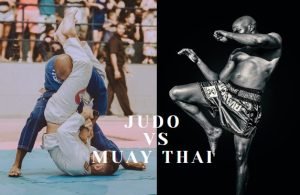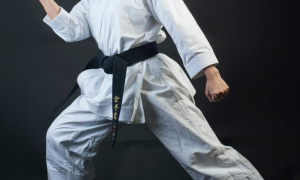
When it comes to the martial arts landscape, Judo vs Muay Thai emerges as a compelling comparison. These two practices, widely recognized for their efficacy, diverge significantly in their approaches to unarmed combat. This exploration aims to shed light on the core disparities between Judo and Muay Thai.
Judo and Muay Thai, though both popular martial arts, showcase distinct methodologies. Judo revolves around grappling and throws, focusing on immobilizing an opponent. In contrast, Muay Thai is a striking art, emphasizing powerful punches, kicks, elbows, and knees. While Judo excels in close-quarters combat and leverage-based throws, Muay Thai’s strength lies in delivering devastating blows from a distance. These differences in techniques and approaches render Judo more effective for grappling and control, while Muay Thai is favored for stand-up striking prowess.
Table of Contents
Toggle![]()
Judo vs Muay Thai: Who Would Win?
In a street encounter between a skilled Judo practitioner and Muay Thai fighter, the judoka likely holds the advantage. Judo’s proficiency in takedowns enables swiftly neutralizing strikes by clinching and executing throws. On the ground, the Judo fighter excels with submissions and pins. Muay Thai relies heavily on strikes, which are mitigated if the fight goes to the ground. Scrambling to their feet exposes the Nak Muay to more takedown attempts.
Overall, Judo’s takedowns and ground skills allow dictating the fight’s dynamics. For the Muay Thai practitioner, their best strategy is evading the clinch, but the judoka still holds greater control.
| Judo’s Street Fight Advantages | Muay Thai’s Street Fight Advantages |
|---|---|
| Proficient takedowns and throws | Devastating striking techniques |
| Skilled ground grappling | Powerful kicks, knees, elbows |
| Can dictate where the fight takes place | Excellent footwork and angles |
Judo’s Advantage in a Street Fight
In the realm of street fights, Judo’s grappling-focused foundation sets it apart. Armed with throws, pins, joint locks, and chokes, judo practitioners are primed to swiftly neutralize threats. When facing a Muay Thai adversary, a judoka’s strategic move involves sidestepping striking exchanges and promptly moving in for a clinch followed by a takedown. The moment the fight reaches the ground, the judoka’s proficiency in pins and submissions can effectively control or incapacitate the Muay Thai opponent.
Judo’s strength in close-quarters combat grants it a tactical edge. By swiftly transitioning from the clinch to grappling, a judoka can negate Muay Thai’s striking prowess and maneuver the battle to their favored ground-based domain.
Muay Thai’s Strength in a Street Fight
Muay Thai fighters stand out as formidable strikers, honing the art of powerful punches, kicks, elbows, and knees. Their relentless conditioning regimen equips them with devastating striking tools capable of dictating the pace of a fight.
When confronting a judoka in a street fight, a Nak Muay must leverage footwork and angles to evade being clinched. Their striking arsenal grants them a distinct upper hand in stand-up exchanges. In the event of a takedown, quick recovery and scrambling back to their feet become paramount. Muay Thai’s focus on well-timed strikes, especially from a distance, positions them to dictate the flow of the altercation.
In essence, the outcome of a Judo vs Muay Thai street fight largely depends on the ability of each martial artist to capitalize on their unique strengths and exploit the vulnerabilities of their opponent.
![]()
Judo vs Muay Thai for Self-Defense
When it comes to self-defense, the comparison between Judo and Muay Thai becomes crucial. Both martial arts offer unique strengths that can be harnessed to protect oneself in real-world situations. Judo’s emphasis on throws, pins, and controlled immobilization complements Muay Thai’s potent striking techniques. Exploring the advantages of each art in a self-defense context helps individuals make informed decisions based on their preferences and circumstances.
Judo for Self-Defense
Judo stands as a potent self-defense tool, offering effective techniques for subduing attackers. Its repertoire of throws enables defenders to swiftly bring assailants to the ground, incapacitating them with well-executed maneuvers. Throws like the hip toss are designed to slam opponents forcefully onto their backs, neutralizing threats effectively.
Moreover, judo’s emphasis on control aligns with self-defense principles. Techniques such as pins, locks, and chokes allow defenders to immobilize aggressors without causing significant harm, focusing on neutralization rather than injury.
Advantages of Judo for Self-Defense:
- Effective throws for incapacitation.
- Control techniques that neutralize threats.
- Minimizes harm to both parties.
Muay Thai for Self-Defense
Muay Thai’s focus on powerful strikes provides practitioners with impactful tools for real-world self-defense. The martial art’s repertoire includes devastating blows delivered through punches, kicks, elbows, and knees, enabling practitioners to deter attackers effectively.
However, Muay Thai’s emphasis on powerful strikes carries inherent risks. Delivering forceful strikes can potentially cause permanent damage. In self-defense scenarios, the key lies in disciplined and controlled application to prevent excessive harm while ensuring personal safety.
Advantages of Muay Thai for Self-Defense:
- Potent strikes for effective defense.
- Teaches techniques to deter and incapacitate attackers.
- Requires precise application to ensure controlled force.
In the context of self-defense, the choice between Judo and Muay Thai involves considering personal values and tactical preferences. Both martial arts provide distinct advantages, and their effectiveness depends on the practitioner’s ability to apply them judiciously to ensure personal safety and minimize harm.
![]()
Is Judo or Muay Thai Better for MMA?
In the dynamic world of mixed martial arts (MMA), the comparison between Judo and Muay Thai holds significance. Both martial arts have demonstrated their prowess within the MMA arena, showcasing their unique attributes and contributions.
Muay Thai’s Striking Arsenal:
Muay Thai’s offensive striking style equips fighters with potent tools for stand-up engagements. With a diverse range of strikes including kicks, punches, elbows, and knees, Muay Thai practitioners possess dangerous offensive capabilities on their feet. Notably, the incorporation of knees and elbows within the clinch sets Muay Thai apart, enabling fighters to excel in close-quarters striking encounters within the MMA cage.
Judo’s Versatile Control and Takedowns:
Conversely, Judo offers a versatile skill set encompassing takedowns and throws that empower fighters to dictate the course of action. Judo’s techniques enable fighters to manipulate their opponents’ positions, compelling the fight to unfold in their desired range. Additionally, Judo’s influence on submission grappling provides fighters with valuable tools for achieving victory on the ground.
Synergy in MMA:
The MMA realm has witnessed the success of both Judo and Muay Thai practitioners, underscoring their effectiveness in this multifaceted sport. Many fighters opt for a combination of Judo and Muay Thai skills, leveraging the strengths of both disciplines. This amalgamation proves highly potent, allowing fighters to excel in various aspects of MMA. This in stark contrast to other martial arts such as Aikido or Thai Chi which are rarely see within the arsenal of fighters.
Differences Between Judo and Muay Thai
When comparing Judo and Muay Thai, it’s essential to recognize the distinctive techniques and objectives that shape these two martial arts. Here’s an overview of the key differences in their approaches:
Key Technical Differences
Understanding the strategic and philosophical differences between Judo and Muay Thai requires breaking down their contrasting approaches to technique. This table highlights the major tactical differences that distinguish a judoka from a Nak Muay. Recognizing these core distinctions provides perspective on the diverse skills each martial art develops.
| Judo | Muay Thai | |
|---|---|---|
| Core Techniques | Throws, takedowns, pins, joint locks, chokes | Punches, kicks, knees, elbows |
| Main Targets | Balance, control of body and gi jacket | Vital strike points on head, body, legs |
| Primary Tactics | Grip fighting, off-balancing, leverage, timing | Combinations, angles, footwork, head movement |
| Distance | Close body-to-body clinching and grappling | Long/mid-range striking, close-range clinch |
| Goal | Throw or takedown into pin or submission | Knockout or overwhelm opponent with strikes |
Sports Rules vs. Realistic Fighting
While Judo and Muay Thai techniques diverge significantly, examining how their sport rulesets differ from real combat scenarios is also informative. The restrictions and allowances in competition influence how each martial art must adapt its methods for reality-based self-defense. This table outlines key factors to consider regarding the transition from sport training to practical fighting ability. Taking note of these vital differences is crucial for bridging the gap between classical martial arts and real-world conflicts.
| Judo Sport Rules | Muay Thai Sport Rules | Realistic Fighting | |
|---|---|---|---|
| Striking | Not allowed | Core element of sport | Essential skill |
| Grappling | Main focus of sport | Limited clinch work | Key for control and defense |
| Gi Grips | Fundamental skill | Not applicable | Limited utility without gi |
| Takedowns | Emphasized | Not trained | Critical in real fights |
| Leg Grabs | Restricted | N/A | Useful against trained strikers |
| Groundwork | Extensive training | None | Important secondary skill |
Judo and Muay Thai: Advantages and Disadvantages
Understanding the strengths and limitations of both Judo and Muay Thai is crucial for making informed decisions about which martial art aligns best with your goals. Let’s explore the advantages and disadvantages of each:
| Judo Advantages | Muay Thai Advantages |
|---|---|
| Proficient at close quarters combat | Devastating offensive striking |
| Throws neutralize size/strength | Develops great physical conditioning |
| Controlled takedowns | Excellent head movement and footwork |
| Judo Disadvantages | Muay Thai Disadvantages |
| Limited striking skills | Struggles against grappling specialists |
| Sport rules restrict techniques | May cause permanent damage |
| Gi grips offer limited benefit in MMA/self-defense | Must adapt techniques for MMA/self-defense |
Is Judo and Muay Thai a Good Combination?

Simply put, combining Judo and Muay Thai gives martial artists access to the best of both worlds in striking and grappling. Each style fills gaps the other may have. Together they form a dynamic, complementary skillset.
For MMA fighters and competitive martial artists, cross-training Judo and Muay Thai unlocks new possibilities in the cage or ring.
The Judo practitioner gains devastating Thai kicks and knees to add to their stand-up game, making takedowns easier to access. Muay Thai fighters learn takedowns to dictate ground exchanges and expand their submission defense.
On the street, a fighter trained in both arts is extremely adaptable. If striking is not an option, they can rely on Judo takedowns. If grappling is dangerous, Muay Thai weapons give them options. A true hybrid fighter is able to seamlessly flow between Judo and Muay Thai tactics from any range or position.
At an expert level, integrating Judo and Muay Thai creates opportunities for unique hybrid techniques. Examples include Judo trips and sweeps flowing into Muay Thai knees, or Muay Thai clinch and elbow setups blended into Judo hip throws.
While it takes immense skill to blend them fluidly, dedicated training makes the combination smooth and innate. Together Judo and Muay Thai ultimately forge uniquely complete martial artists and fighters.
![]()
FAQ
![]()
Is Judo the toughest sport?
Judo is certainly among the most demanding and challenging sports in the world. The intense grappling exchanges require immense strength, endurance, and mental toughness. Competition judoka also must have incredible pain tolerance. Overall, judo ranks high for general physical and mental difficulty.
Is there kicking in Judo?
Competitive judo does not allow kicking or striking during matches. The focus is on throws, pins, locks and chokes. However, some traditional judo schools do incorporate limited kicking and striking techniques in their broader curriculum. These are not permitted in competition.
So kicking is generally not part of sport judo, but may play a contextual role in self-defense oriented judo training.
What is Muay Thai’s weakness?
Muay Thai’s primary weakness is a lack of grappling ability. Without takedown or ground fighting skills, Muay Thai fighters can struggle against grappling specialists. Developing clinch work, takedown defense, and submission grappling can help offset this limitation.
Does Muay Thai build muscle?
Yes, Muay Thai training builds significant muscle, especially in the legs, core, shoulders and arms. The combination of heavy bag work, pads, clinching and sparring provides a full-body workout that develops lean, functional muscle mass. Diet and weight training can further enhance Muay Thai’s muscle-building benefits.
![]()
Conclusion
Judo and Muay Thai offer two very different approaches to unarmed combat. While both martial arts are highly effective, they require practitioners to develop different skill sets based on contrasting techniques and strategies. One’s personal preferences and goals will determine which martial art is better suited to their needs. Any martial artist is encouraged to explore and cross-train both disciplines to become a more adaptable, well-rounded fighter.


